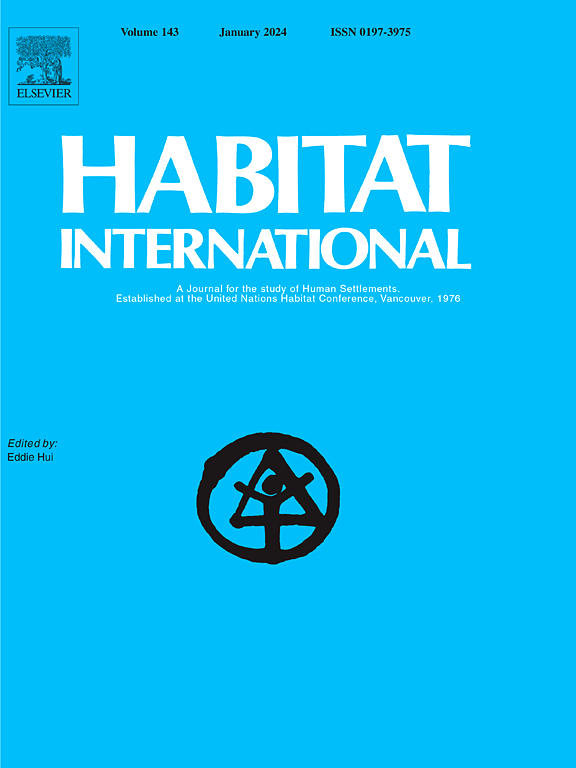How does the mixed-functional land use pattern suppress the cooling capacity of urban green spaces? Evidence from China
IF 7
1区 经济学
Q1 DEVELOPMENT STUDIES
引用次数: 0
Abstract
Urban green spaces are widely recognized for their role in mitigating urban heat through ecological processes such as evapotranspiration and shading. However, the intensification of compact and mixed-functional land use patterns may constrain their thermal regulatory performance. This study investigates the extent to which mixed-functional land use patterns modulate the cooling capacity of urban green spaces across 287 Chinese cities, employing a multi-method framework that integrates spatial regression models, multi-scale geographically weighted regression (MGWR), and interpretable machine learning (XGBoost with SHAP values). The results indicate that mixed-functional land use significantly suppresses green space cooling through three main pathways: (1) by increasing landscape fragmentation, it disrupts spatial continuity; (2) by intensifying competition with built-up areas, it diminishes marginal cooling gains; and (3) by interacting with green space morphology, it selectively impairs the thermal performance of planned urban green spaces (PDUGS), while natural urban green spaces (NAUGS) remain relatively resilient. Empirical evidence supports these mechanisms: the MIXD (degree of mixed-functional land use pattern) × PDUGS coverage interaction yields a significantly negative coefficient (β = −0.000865) in the cold island area model, and MGWR identifies stronger suppressive effects in high-density southern cities. SHAP-based threshold analysis identifies a suboptimal MIXD range (≈55–240) associated with markedly reduced cooling capacity, and a saturation point beyond ≈405 where additional functional mixing yields diminishing returns. These findings highlight the conditional role of urban form in shaping green infrastructure performance and underscore the importance of adopting type-specific and structure-sensitive planning strategies to optimize green space effectiveness under compact urban development.
多功能土地利用模式如何抑制城市绿地的降温能力?来自中国的证据
城市绿地因其通过生态过程(如蒸散发和遮阳)在缓解城市热量方面的作用而得到广泛认可。然而,紧凑和混合功能土地利用模式的强化可能会限制其热调节性能。本研究采用多方法框架,结合空间回归模型、多尺度地理加权回归(MGWR)和可解释机器学习(带SHAP值的XGBoost),研究了中国287个城市混合功能土地利用模式对城市绿地降温能力的调节程度。结果表明,混合功能土地利用通过三个主要途径显著抑制绿地降温:1)增加景观破碎化,破坏空间连续性;(2)通过加强与建成区的竞争,降低了边际降温收益;(3)通过与绿地形态的相互作用,它选择性地削弱了规划城市绿地(PDUGS)的热性能,而自然城市绿地(NAUGS)保持相对弹性。经验证据支持这些机制:在冷岛地区模型中,混合功能土地利用模式程度(MIXD)与PDUGS覆盖相互作用产生显著的负系数(β = - 0.000865),而MGWR在高密度的南方城市中具有更强的抑制作用。基于shap的阈值分析确定了与冷却能力显著降低相关的次优MIXD范围(≈55-240),以及超过≈405的饱和点,此时额外的功能混合会产生递减的回报。这些研究结果强调了城市形态在塑造绿色基础设施绩效方面的条件作用,并强调了在紧凑型城市发展下,采用特定类型和结构敏感的规划策略来优化绿色空间有效性的重要性。
本文章由计算机程序翻译,如有差异,请以英文原文为准。
求助全文
约1分钟内获得全文
求助全文
来源期刊

Habitat International
Multiple-
CiteScore
10.50
自引率
10.30%
发文量
151
审稿时长
38 days
期刊介绍:
Habitat International is dedicated to the study of urban and rural human settlements: their planning, design, production and management. Its main focus is on urbanisation in its broadest sense in the developing world. However, increasingly the interrelationships and linkages between cities and towns in the developing and developed worlds are becoming apparent and solutions to the problems that result are urgently required. The economic, social, technological and political systems of the world are intertwined and changes in one region almost always affect other regions.
 求助内容:
求助内容: 应助结果提醒方式:
应助结果提醒方式:


